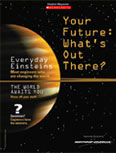  |
| >Mission: Define Your Future home | |||
| Lesson 1: Are We Alone in the Universe? Goal: Discover how technology has improved our knowledge of the universe Time Required: 80 minutes (two 40-minute class periods)
Directions: 2. Discuss how scientists are able to use technology to test theories, perform experiments, and gather information that helps them acquire facts to answer this question. 3. Review these key definitions: solar system (a system of planets and other bodies orbiting a star such as the sun); orbit (an invisible path followed by an object circling another body); sun (the star around which the earth and other planets revolve; a huge ball of hot gases that gives off intense light and heat and is necessary to all life on Earth). Distribute Are We Alone in the Universe? Student Reproducible 1. 4. Guide students in researching answers to the questions on the reproducible and sharing their findings in a class discussion. Wrap-Up: Answer Key:
Photos, top to bottom: © Denis Scott/Taxi/Getty Images; © NASA.
|
Student Magazine Your students can meet engineers who are changing the world each day! These engineers have mastered math and science to improve the way we live. Now it's your students' turn. What will they do? Challenge them to improve the world. • Your Future: What's Out There? Find Out Now (PDF) Generously sponsored by: |
||
 Materials
Required:
Materials
Required: 